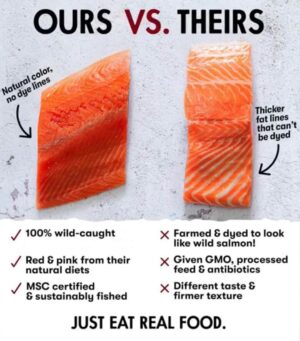Salmon is one of the most popular fish globally, loved for its rich flavor and impressive health benefits. However, not all salmon is created equal. The choice between wild salmon and farmed salmon can significantly affect your health and the environment. In this blog post, we’ll dive into the key differences between wild and farmed salmon, explore why farmed salmon is bad for your health, and explain why wild Canadian salmon is widely regarded as the best in the world.
What is Wild Salmon?
Wild salmon are fish that thrive in their natural habitats—rivers, lakes, and oceans. Born in freshwater, they migrate to the sea to mature and return to spawn, living a life dictated by nature. Their diet consists of smaller fish, plankton, and marine life, giving them a lean build, vibrant color, and distinct flavor. Caught using sustainable fishing methods, wild salmon embody the essence of nature’s finest offerings.
What is Farmed Salmon?
In contrast, farmed salmon—also known as aquaculture salmon—are raised in controlled environments like fish farms or pens, typically in coastal waters. These salmon are fed a processed diet of fish meal, often mixed with grains, soy, and artificial coloring to mimic the pinkish hue of wild salmon. While fish farming meets the growing demand for salmon, it introduces several health and environmental concerns that make farmed salmon a less desirable choice.
Key Differences Between Wild and Farmed Salmon
The differences between wild salmon and farmed salmon go beyond their origins. Here’s a breakdown of how they compare, with a focus on health impacts:
Diet and Nutrition
- Wild Salmon: Their natural diet of marine life provides high levels of omega-3 fatty acids, vitamins, and minerals. This contributes to their superior nutritional profile.
- Farmed Salmon: Fed a controlled diet of fish meal and additives, farmed salmon often have lower nutritional value. Studies show they have a less favorable omega-3 to omega-6 ratio compared to their wild counterparts.
Environment and Lifestyle
- Wild Salmon: Swimming freely in open waters builds strong muscles and leaner flesh, enhancing their quality.
- Farmed Salmon: Confined to crowded pens, they lead a sedentary life, resulting in higher fat content and less muscle development.
Health Implications
The health differences are where farmed salmon truly fall short. Let’s explore why.
Why Farmed Salmon is Bad for Your Health
While farmed salmon may be more affordable and widely available, their health risks outweigh the convenience. Here’s why farmed salmon can harm your well-being:
1. Contaminants and Pollutants
Farmed salmon are often exposed to higher levels of harmful pollutants like PCBs (polychlorinated biphenyls) and dioxins. These toxic chemicals accumulate in their flesh due to polluted farm waters and contaminated feed. Research has linked PCBs and dioxins to serious health issues, including cancer, immune system damage, and developmental problems in children.
2. Antibiotics and Pesticides
Crowded conditions in fish farms make farmed salmon prone to diseases and parasites, such as sea lice. To combat this, farmers use antibiotics and pesticides, which can remain in the fish and transfer to consumers. Overexposure to antibiotics may contribute to antibiotic resistance, a growing global health concern.
3. Lower Omega-3 Content and Higher Fat
While farmed salmon contain omega-3 fatty acids, their levels are often lower than in wild salmon. Additionally, their sedentary lifestyle and processed diet lead to higher levels of unhealthy saturated fats. This imbalance reduces the heart-healthy benefits salmon is known for.
Choosing farmed salmon over wild salmon means risking exposure to contaminants, chemicals, and a less nutritious fish—all of which make it a poor choice for your health.
Why Wild Canadian Salmon is Regarded as the Best in the World
When it comes to quality, flavor, and sustainability, wild Canadian salmon stands out as the gold standard. Here’s why it’s celebrated globally, especially from regions like British Columbia:
1. Exceptional Quality and Flavor
The cold, pristine waters of the Pacific Northwest provide an ideal habitat for wild Canadian salmon. Their natural diet and active lifestyle result in firm, flavorful flesh with a rich, authentic taste. Whether grilled, baked, or smoked, Canadian salmon delivers a culinary experience unmatched by farmed salmon.
2. Sustainability and Eco-Friendliness
Canada’s salmon fisheries, particularly in British Columbia, are managed with strict regulations to ensure sustainability. Practices like limited fishing seasons, catch quotas, and habitat protection maintain healthy salmon populations and protect the ecosystem. By choosing wild Canadian salmon, you’re supporting environmentally responsible fishing that preserves our oceans for future generations.
3. Variety of Species
Wild Canadian salmon come in several species, each with unique traits:
- Sockeye Salmon: Famous for its deep red color and bold flavor.
- Coho Salmon: Offers a mild taste and firm texture.
- Chinook Salmon: The largest species, known for its buttery richness.
- Pink Salmon: Delicate and versatile, often used in canning.
This diversity makes wild Canadian salmon a favorite among chefs and home cooks alike.
4. Superior Health Benefits
Wild Canadian salmon boast higher levels of omega-3 fatty acids, which support heart health, brain function, and inflammation reduction. With lower fat content and minimal exposure to contaminants, they’re a cleaner, healthier option compared to farmed salmon.
Conclusion: Make the Switch to Wild Canadian Salmon
The choice between wild salmon and farmed salmon is clear. While farmed salmon may seem convenient, their health risks—contaminants like PCBs and dioxins, antibiotics, pesticides, and lower omega-3 levels—make them a risky option. In contrast, wild Canadian salmon offer unbeatable flavor, top-tier nutrition, and a commitment to sustainability. Sourced from the pristine waters of British Columbia, these fish are the best choice for your health and the planet.
Next time you’re shopping or dining out, opt for wild Canadian salmon. Your body—and the environment—will thank you.

